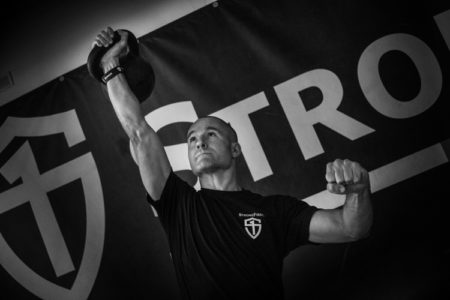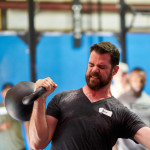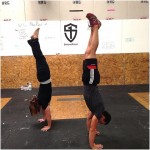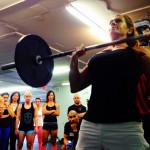We all want a stronger kettlebell press. Boosting your strength baseline makes everything else, everything before, relatively easier. But strength isn’t just about your muscles: it’s about your brain. So finding and using principles, techniques and drills that unlock your ability to better express the strength that you do have is something to strive for. Here Master Instructor Pavel Macek lets you in on a kettlebell press drill to get you pressing stronger NOW. The pull press.
You learn a lot from your teachers. Then you figure out the details by patient practice. And, almost always, you learn from your students.
Qui docet, discit—who teaches, learns…
This is my case: every opportunity I have to teach, I learn. I am, above all, a student of strength.
I came up with the kettlebell “pull press” drill after watching magnificent press displays, dutifully accompanied by a grunt and power breathing, at the many kettlebell instructor certifications where I have had the honor to teach and assist.

But before I share my technique, that will almost instantly make your one-arm military press stronger, let’s briefly review well-known press variations and press standards.
Alternating Press and See-Saw Press
If you have been through an SFG Level 1 Certification, I’m sure you remember the alternating kettlebell press. If you’ve not yet attended, it looks like this: clean two kettlebells; press one to lockout; pull it back into the rack; press the other to lockout; pull it back to the rack. That’s one repetition.
With one kettlebell in the rack, the opposite side’s press is usually easier. The extra load gives you a great counterbalance while helping to keep your torso tight to minimize tension leaks.
The see-saw kettlebell press differs slightly. As with the alternating press, you clean two kettlebells and press one. But this time, using the active-negative principle, you pull it back into the rack position while simultaneously pressing the other kettlebell up. Repeat on the other side, continuing for your desired reps.
In the old days, dumbbell and kettlebell see-saw presses were very popular. The legendary Milo Bar Bell Company’s The Second Progressive Course of Instructions (1924), gives brief instructions on the exercise and highlights interesting details that are well-known to today’s Hardstyle kettlebell lifters:
“Push the right hand aloft, and then, as you lower the right hand, push the left hand aloft. KEEP BOTH ARMS WORKING at the SAME time, but in opposite directions.”
“…make sure that you are holding the kettle-bells in the CORRECT MANNER. Note that the athlete does NOT allow the wrist to bend backwards so that the kettle-bells rest against the elbows. If you bend the wrist backwards, the kettle-bell hangs down so far that it interferes with the bending of the arms; therefore, bend the wrists FORWARD and this will make the kettle-bells rest against the back of the forearms.”
Old-timers may have done the exercise a bit differently than we do it today, for different reasons. But it doesn’t matter. See-saw presses rock.
So how can we apply the see-saw’s advantages to a single kettlebell? Enter the “virtual see-saw press” or “pull press.”
Skill of Strength
We pack our StrongFirst military press teaching block with details for a reason. We reveal many secrets—I don’t hesitate calling them that, but could have called them magic—and universal principles of strength. Rooting, wedging, bracing, feed-forward tension, power breathing, trigger, and many, many more reverse-engineered nuances that are every bit as applicable to squats and deadlifts as they are to presses. Because they deliver. (More articles to come.)
Applying even one of these technique boosters can immediately increase your strength by 1-2%. Now imagine how much stronger you could get by applying two or more in just a few days, weeks, or months of practice?
Overzealous wishful thinking perhaps?
Not at our SFG certifications, where experience has taught us to expect it. After covering our material, roughly 30% of students hit a personal press record, lifting a heavier kettlebell than they ever had before. A lifetime PR in a few minutes.
Three Old-School Press Options for the Non-Lifting Hand
In one-arm lifts—one-arm swing, get-up, clean, snatch, press, push press, jerk, bent press—pay careful attention to the non-lifting hand. Give it some work to make the lift safer and easier. Popular examples include:
- synchronizing the downswing and upswing in the swing, snatch and clean,
- using the non-lifting hand for support in the bent press and the get-up,
- squeezing the opposite hand to trigger a kettlebell front squat and before ascending from the get-up’s split squat position.
How about in the one-arm military press? Old-timers preferred 3 different ways:
- Pressing the free hand tight against your body and thigh
- Holding it out to the side
- Holding it at the waist, as taught by Pavel in Enter the Kettlebell
The original strict military press strength test—with heels together and zero body movement allowed—used the first two options.
Pull Meets Press
We new-timers, have another option: the pull press.
While watching students practice their strict press at kettlebell certifications—particularly when loads got heavy, or when they got tired—I noticed some adopting a technique we don‘t teach. As they lowered the kettlebell to the rack, they raised their free hand. Then (using the trigger and other principles), they pulled the free hand downward, while simultaneously pressing the kettlebell overhead. Pull meets press.
That caught my attention. And after adding it to my practice and teaching, it helped me and my students press heavier weights, or press the same weight for more reps. This was perfect training for our gyms’ beginner press program from the StrongFirst Kettlebell Course. Here is a video for those that want a more in-depth explanation.
You will see assistance drills that can help you perfect the pull press technique, such as the Pat Casey press (holding on to something at chest level with the free hand—a technique I learned about in Pavel’s ETK) and a band pull press (from Kenneth Jay, who wrote about the “contralateral push-pull mechanism” years ago).
The final goal, however, is to use the “pull press” technique without a rack or band during your regular one-arm (repetition) presses.
Pull Press—not a “Push Up”!
Important note: Pay attention not to turn the military press into what the old-timers called “push up”—basically a side body push press.
Calvert writes in The Truth About Weight Lifting (1911):
[Some lifters] will give themselves a start by bending first to one side, then straightening suddenly in order to give momentum to the bell and finishing the lift with a bend to the other side.
To explain more fully, suppose a lifter has a bell in his right hand, as he starts the lift he will drop the right shoulder and bend 3 or 4 inches to the right; then he will heave the bell aloft, using the strength of the side muscles to start the bell upwards, and as the bell goes upward he will bend the body far to the left.
A legitimate lift, but not what we’re after. Make sure that the weight in the rack does not sink down before the actual press. All SFG military press standards still apply.
Whether you use the pull press to your advantage or not, consciously or not, don‘t be deceived by its simplicity. Like compound interest in a savings account, strength principles add up to tangible gains. The pull press can be another small but significant piece in the puzzle towards improving your one-arm press.
Try it out and let me know in the comments below the article or in our StrongFirst discussion forum how it goes
Special thanks to my friend Aleks Salkin, SFG II, SFB for proofreading and editing.
Pay attention not to turn the military press into...a side body push press. – Pavel Macek Share on XResources Mentioned
Return of the Kettlebell – Book by Pavel Tsatsouline











I saw this method in the book by Kenneth Jay, “Perfecting the Press.”
Yes sir – as you can see above, proper credit is given in the article:
“… a band pull press (from Kenneth Jay, who wrote about the “contralateral push-pull mechanism” years ago).”
Wow…it is so simple and logical. I love it! Thank you Pavel, I can’t wait to try it.
Thank you brother, let me know how it works for you!
Jeff, I have “figured it out” exactly like this – by watching what many of my fellow SFGs were doing and then “reverse-engineered” it. Not my invention – many of my colleagues had similar observation before, I just thought it is cool and it deserves some attention, hence the article and videos.
I think the old school strict military press is a great specialized variety drills, but I like our SFG standard military press better.
Thank you for your kind words!
Thank you for taking the time to respond Pavel, appreciated. Finally, if you wouldn’t mind, for the SFG standards, if you could only train and recommend one or the other, would it be the single or double military press?
Jeff, single ir double kettlebell military press? The answer is yes.
Alright… From all overhead kettlebell presses I personaly love bent press most.
Right on, thanks again
Really great article, Pavel! This is one of those techniques that so many do and so few stop to consider, let alone teach. Hopefully we’ll start seeing some big PRs on the way after readers add this to their pressing regimens!
Thank you brother, and as always, thank you very much for proofreading and editing the article.
Ahoj Pavel!
Simply a great article!
Just as Jeff above, I’m also wondering how the classic heel-to-heel position would with the loaded clean. After all you need to put your feet to the sides which might cause some power leaks.
Can you share your insight on this?
Thanks!
The way the strict old-school military press was tested was like this: snatch, get your feet set, pull the bell to the rack, press. There was a strict pause both in the rack and final lockout – you had to wait for judges’s commands.
If you want to clean the bell and press, adjust the feet on the fly, during your clean.
Thanks for this Pavel. Just recently I noticed my free arm unconsciously doing some funky things up in the air when struggling, I will pay attention to this. What do you think of the old-time strict military press standard? Is it better, or are the StrongFirst standards enough?
Nice to see that you have achieved Master Instructor—well done.
Jeff, sorry for late reply, I didn’t get the notification.
I like the StrongFirst press (as an exercise) and standard more than the old super-strict military press – I think it is happy medium with great transfer.
Thank you for your kind words, sir, happy and ready to serve!